Mary Chandler
Early Life
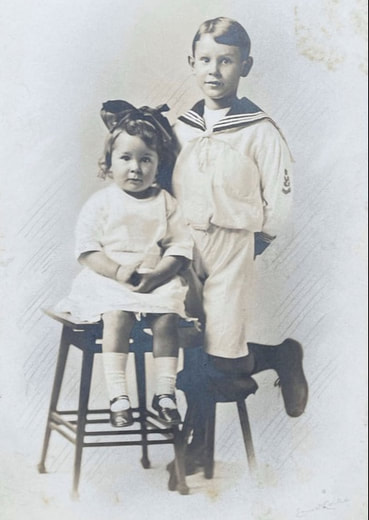 Mary and her brother Tom c. 1913
Mary and her brother Tom c. 1913
Kathleen "Mary" Chandler was born into a wealthy British family on May 16, 1911 to Kathleen Jane (Wills) Chandler and Thomas Richard Chandler in Eltham, an area in southeastern London. Her father was the Managing Director of the Woolwich Equitable Building Society, while her mother stayed home to take care of Mary and her brother Thomas who was five years older than she.
Around the age of three she began learning piano because she was jealous of the special treatment her brother was perceived to be receiving by taking lessons. She would later remember that reading and writing came to her with some difficulty because she first learned to read music, not words.
Mary began kindergarten during World War I at Babington House, a local private school, just as her brother Thomas had before her. The school was housed in a large, grey Victorian building along a dirt road, which Mary remembered having trouble arriving without mud all over her shoes. She even remembered arriving for her first day and immediately changing into house shoes after she arrived. After the war ended in 1918 her parents, who had observed her hearing phantom noises and biting her nails due to trauma from living through the war, decided it was time for her to attend boarding school away from London.
Around the age of three she began learning piano because she was jealous of the special treatment her brother was perceived to be receiving by taking lessons. She would later remember that reading and writing came to her with some difficulty because she first learned to read music, not words.
Mary began kindergarten during World War I at Babington House, a local private school, just as her brother Thomas had before her. The school was housed in a large, grey Victorian building along a dirt road, which Mary remembered having trouble arriving without mud all over her shoes. She even remembered arriving for her first day and immediately changing into house shoes after she arrived. After the war ended in 1918 her parents, who had observed her hearing phantom noises and biting her nails due to trauma from living through the war, decided it was time for her to attend boarding school away from London.
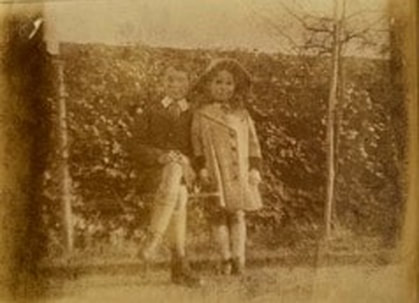 Mary and her brother Tom c. 1915
Mary and her brother Tom c. 1915
In January 1919, Mary boarded the Torbay Express with two of her cousins to attend The Tudor's School in the southwestern resort town of Torquay. The school was a very small boarding school run by a Frenchwoman and her mother. Previously they ran a finishing school in France, but at the outbreak of war came to England.
While at the school the girls were required to speak French and received a lot of their education from visiting teachers that came once a week teaching various art activities as well as "other refinements of a ladylike education." One of the weekly visitors was her piano teacher, who she remembered was much kinder than her teacher back home in London. At her young age Mary must have been much more advanced than many of the other students, and because of that was given more advanced repertoire to work on. In 1928 Mary graduated and moved back home to London to live with her parents.
While at the school the girls were required to speak French and received a lot of their education from visiting teachers that came once a week teaching various art activities as well as "other refinements of a ladylike education." One of the weekly visitors was her piano teacher, who she remembered was much kinder than her teacher back home in London. At her young age Mary must have been much more advanced than many of the other students, and because of that was given more advanced repertoire to work on. In 1928 Mary graduated and moved back home to London to live with her parents.
Gap years
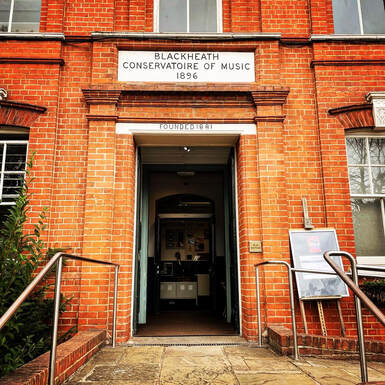 Entrance to the Blackheath Conservatoire
Entrance to the Blackheath Conservatoire
After Mary finished at The Tudor's School, she moved back to live with her parents, who had moved from Eltham to the nearby area of Lewisham. Her aunts and grandmother, who she spent a lot of her time with during her gap years before college, also lived nearby. Her "spinster "aunts (as she called them), who she admired, taught her many of the pleasures of adulthood, such as smoking and drinking pink gin. They also tried to find men to entertain her at parties, but Mary found them all "painfully shy and totally uninteresting."
Mary's main interest after school was her music. She enrolled at the Blackheath Conservatoire in Autumn 1928 to study composition with Harry Farjeon and piano with Annette B. Gibson. It was this same year she would make her first attempt for an L.R.A.M., but not succeed, leaving her disappointed. Her study at Blackheath helped to prepare her for future attempts, as the following year she won a scholarship for tuition. Mary was also playing occasionally with the Illyrian Dramatic Society, a city based organization where her aunt Ethel frequently played the lead in the plays.
By late 1929 Mary was set to follow in her aunt's footsteps and enter civil service. She decided that she would attend Somerville College at Oxford to start down that path. After she was accepted her soon-to-be teacher suggested she spend a few months in Paris at the Sorbonne attending a Cours de Civilization Française to mature a little before Somerville. Her time there in winter 1930 was spent attending lectures, sightseeing, and soaking in the Parisian culture. She also was still preparing herself to pass an L.R.A.M. for piano, and remembered playing playing piano for her new friends. When she returned, she felt she was ready to tackle her new adventure of an Oxford life.
Mary's main interest after school was her music. She enrolled at the Blackheath Conservatoire in Autumn 1928 to study composition with Harry Farjeon and piano with Annette B. Gibson. It was this same year she would make her first attempt for an L.R.A.M., but not succeed, leaving her disappointed. Her study at Blackheath helped to prepare her for future attempts, as the following year she won a scholarship for tuition. Mary was also playing occasionally with the Illyrian Dramatic Society, a city based organization where her aunt Ethel frequently played the lead in the plays.
By late 1929 Mary was set to follow in her aunt's footsteps and enter civil service. She decided that she would attend Somerville College at Oxford to start down that path. After she was accepted her soon-to-be teacher suggested she spend a few months in Paris at the Sorbonne attending a Cours de Civilization Française to mature a little before Somerville. Her time there in winter 1930 was spent attending lectures, sightseeing, and soaking in the Parisian culture. She also was still preparing herself to pass an L.R.A.M. for piano, and remembered playing playing piano for her new friends. When she returned, she felt she was ready to tackle her new adventure of an Oxford life.
Oxford and King's College
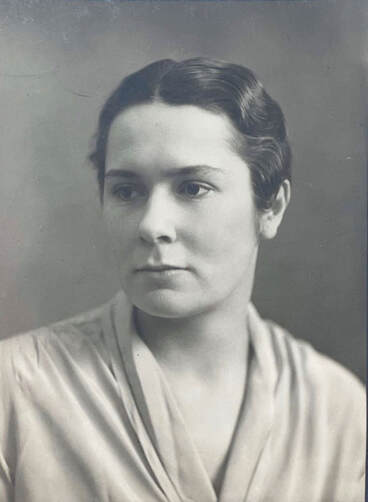 Mary's Oxford portrait
Mary's Oxford portrait
In the Autumn of 1930, Mary began studying English and Literature at Somerville College in Oxford. Just ten years prior, Oxford had finally allowed women to take degrees, so the culture for women, while still much more centric to men, was beginning to change. Mary remembered attending the lectures of C. S. Lewis and J. R. R. Tolkien, and thoroughly enjoying them. Like many students today, Mary was not always sure what she wanted to study while at Oxford. For a short time she considered focusing on Language, but eventually decided to remain with Literature. She still was not completely sure on career yet, still assuming she would enter civil service, though she had not been advised well at the start and did not realize what would be on the civil service exam. She eventually settled on teaching, and after graduating from Oxford in June 1933 attended King's College, London to complete a Diploma in Education, finishing in 1934.
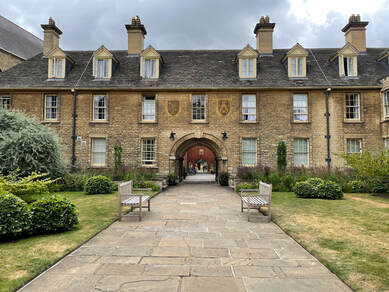 Somerville College courtyard
Somerville College courtyard
During her time at Oxford, Mary not only focused on English and Literature, but continued pursuing her passion for music. She joined the Bach Choir in Oxford conducted by Sir Hugh Allen, and later joined the Eglesfield Choir conducted by Reginald Jacques, who she would later sing under in the Bach Choir of London. She also continued working to achieve an L.R.A.M. in piano performance, achieving that honor in 1931, studying piano with Harold Craxton while she pursued this diploma. She remembered renting a piano at the Taphouse to continue practicing, and likely being a nuisance to to anyone with a room near her.
She also was involved in sports, stating they were high on her priorities. At the Tudor's School she played cricket, though Somerville had no women's cricket team. Instead she played on the college hockey team, though she was not very good and nor was the team. During her time on the team they lost all the available cups and honors, but she enjoyed the physical effort. In the summers she would focus her summer exercise on the river Cherwell learning to punt with friends, though she more preferred using paddles to the punt-pole as it was easier.
She also was involved in sports, stating they were high on her priorities. At the Tudor's School she played cricket, though Somerville had no women's cricket team. Instead she played on the college hockey team, though she was not very good and nor was the team. During her time on the team they lost all the available cups and honors, but she enjoyed the physical effort. In the summers she would focus her summer exercise on the river Cherwell learning to punt with friends, though she more preferred using paddles to the punt-pole as it was easier.
Teaching and World War II
 Channing School in the 1930s
Channing School in the 1930s
Mary began teaching in the Autumn of 1934 at the Channing School, a public girls school in the northwestern London area of Highgate. Little is known of her time here, but in her four years of service she became Senior English Mistress, and it is likely she was involved with producing the plays with the girls. Mary was only here for four years, leaving after the 1937-1938 school year. This move may have been a personal one. Her mother passed away in December 1938, and she was likely sick for months prior to this. In Autumn 1938 she began teaching at the Blackheath High School, another public girls school in southeastern London, just down the road from her parents home in Lewisham.
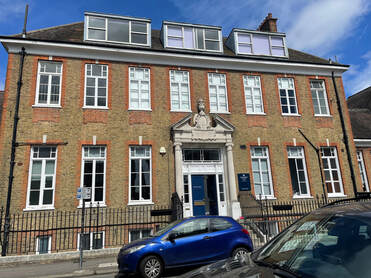 Blackheath High School, Wemyss Road building
Blackheath High School, Wemyss Road building
The change of school also coincided with the advent of World War II. Just as soon as Mary arrived at Blackheath High School
in September 1938, she along with another teaching mistress evacuated with the girls to East Sussex. This only lasted a few days, and they returned back to London, completing the year
in London. The United Kingdom declared war on Nazi Germany in September 1939, and just days before this declaration the girls of Blackheath evacuated to Tunbridge Wells High School, another school in the Day School Trust organization.
Throughout the war Mary spent her days teaching the students and visiting with her father who lived in Bromley, not too far from Tunbridge Wells. During many of the raids and bombings that happened throughout the war Mary journaled to document the events. In one of the days she described was during the Blitz and it being fought out over Tunbridge Wells.
in September 1938, she along with another teaching mistress evacuated with the girls to East Sussex. This only lasted a few days, and they returned back to London, completing the year
in London. The United Kingdom declared war on Nazi Germany in September 1939, and just days before this declaration the girls of Blackheath evacuated to Tunbridge Wells High School, another school in the Day School Trust organization.
Throughout the war Mary spent her days teaching the students and visiting with her father who lived in Bromley, not too far from Tunbridge Wells. During many of the raids and bombings that happened throughout the war Mary journaled to document the events. In one of the days she described was during the Blitz and it being fought out over Tunbridge Wells.
Music shines through
Mary never lost her passion for music, even as she spent ten years teaching English to young girls. In 1935 she joined a musical organization she would be associated with throughout her life, the Society of Women Musicians. This London based organization was formed in 1911 as a response to the limited professional opportunities for women musicians at the time. When Mary joined she was a very active member, serving on the newly formed Junior Committee, which was to bring a youthful element into the Society and seek out young talent. She was also featured in a number of concerts as a pianist and composer, first having her works featured at a concert in March 1936. From 1941-1956 Mary does not show in the annual reports. There is no evidence that she resigned, and it is likely that the war kept her away, along with her time with the City of Birmingham Symphony Orchestra. From 1957 until the society disbanded in 1972 Mary was once again very active. She continued to perform and have her works performed at concerts organized by the society. In 1966 she won first prize in the W. W. Cobbett Prize competition, which was a call for a composition featuring three wind instruments. She submitted her Trio for oboe, clarinet, and horn. The work was performed in June the following year in celebration of her win. In 1970 she won second prize in the Cappiani Prize competition for her Recollections scored for soprano, harp, violin, viola, and cello. It had its first performance in July 1971 for the society's Diamond Jubilee.
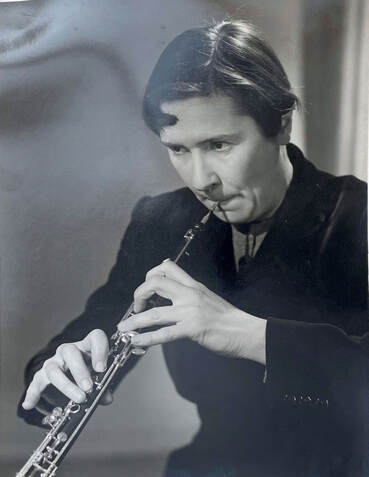 Mary playing her oboe
Mary playing her oboe
At the same time she was a member of the Bach Choir in London under the direction of Reginald Jacques, who she sung with while in the Eglesfield Choir at Oxford. During her first year with the Bach Choir she was a part of the 250th celebration of Johann Sebastian Bach's birth. The Bach Choir presented a three-day festival on March 19, 22, and April 7 performing a number of his cantatas, concertos, the "Mass in B Minor," and the St. Matthew's Passion. She was a member of the choir through at least April 1939. At some point between 1935 and 1939, Mary met the oboist Margaret Eliot when she was playing with the choir, and she agreed to teach her oboe.
In 1942 Mary joined the Tunbridge Wells Symphony Orchestra as an amateur, playing with the group until 1944. At the time she was still evacuated with the girls of Blackheath High School, so it was close by. At the same time she was working towards an A.R.C.M. in oboe performance with Leon Goossens, which she received in 1943.
In 1942 Mary joined the Tunbridge Wells Symphony Orchestra as an amateur, playing with the group until 1944. At the time she was still evacuated with the girls of Blackheath High School, so it was close by. At the same time she was working towards an A.R.C.M. in oboe performance with Leon Goossens, which she received in 1943.
A full-time musician
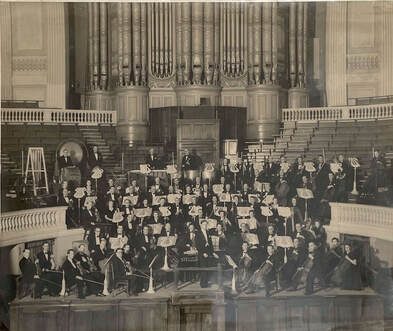 CBSO portrait from 1950
CBSO portrait from 1950
It was in 1944 that Mary decided it was time for a big change in her life. She had been teaching English for ten years, while steadily repositioning herself into the life of a musician. The tipping point came when George Weldon, newly appointed to the City of Birmingham Orchestra (now the City of Birmingham Symphony Orchestra) invited Mary to join as principal oboe. The orchestra had just gone through restructuring, choosing to function as a full-time organization.
During her time with the orchestra, Mary was featured as a composer, oboist, and pianist, throughout her time with the orchestra. She was first featured in 1946, and in the first three months of that year performed Mozart's Piano Concerto No. 23 in A Major and Handel's Concerto Grosso No. 3 in Bb Major with one Birmingham Post review of her Handel performance
During her time with the orchestra, Mary was featured as a composer, oboist, and pianist, throughout her time with the orchestra. She was first featured in 1946, and in the first three months of that year performed Mozart's Piano Concerto No. 23 in A Major and Handel's Concerto Grosso No. 3 in Bb Major with one Birmingham Post review of her Handel performance
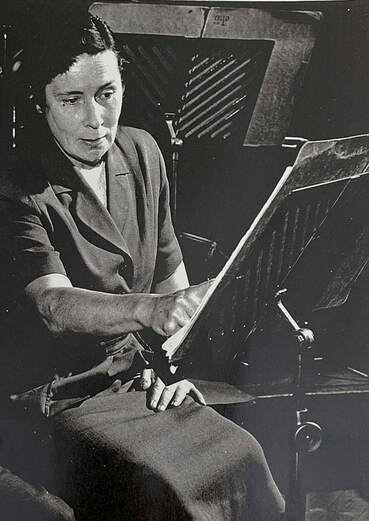 Mary sitting in the orchestra
Mary sitting in the orchestra
stating "The tone was vital and lovely, the phrasing faultless, yet there was no affected prettiness or simpering sentiment. Miss Chandler in fact, has style as well as skill and musicianship." The first piece of hers performed by the CBSO was Trivia in July 1946, and it also produced a glowing review from the Birmingham Post stating that "Miss Chandler is a composer, not just an executive musician straying rashly into an adjacent department." Mary would continue to be featured throughout her tenure with the CBSO, receiving a performance of her oboe d'amore concerto by Leon Goossens, along with numerous other appearances as soloist on oboe and piano.
In 1958 the orchestra was navigating a rough patch, as many of the long-time musicians felt the current conductor was treating another musician without the respect they deserved. Because of that, a number of the musicians chose to walk out on the orchestra, with Mary being one of them. After she left the orchestra she spent a couple years freelancing around the Midlands with her chamber group the Mercian Trio for flute, oboe, and piano.
In 1958 the orchestra was navigating a rough patch, as many of the long-time musicians felt the current conductor was treating another musician without the respect they deserved. Because of that, a number of the musicians chose to walk out on the orchestra, with Mary being one of them. After she left the orchestra she spent a couple years freelancing around the Midlands with her chamber group the Mercian Trio for flute, oboe, and piano.
A return to the classroom
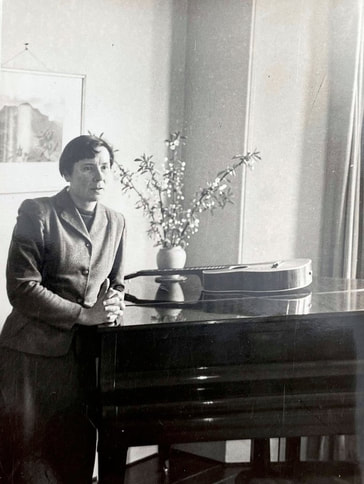 Mary standing next to her piano
Mary standing next to her piano
After two years of freelancing in the Midlands, Mary made the decision to return to the classroom, this time teaching music instead of English. In 1960 she was appointed Assistant Director of the Kent Rural Music School (now Kent Music) to create a new center in Northwest Kent. The Kent Rural Music School was part of the Rural Music School Association, a collection of "community music schools" throughout England, which first started in Hitchin to provide a music education for those outside of large metropolitan areas. At the time of Mary's hiring the Kent Rural Music School had two offices, the main center in Maidstone and a smaller center in Canterbury. The Maidstone center had become too big, and was not fully able to service their current students and reach potential students further northwest from Maidstone, so they chose to expand with a new center. When Mary began in September 1960 she was first tasked to work directly with the director, Murial Anthony, until January 1961 where she would begin her work at the new center in Dartford. As she began her work at the new center, Mary and her team worked in a caravan she assembled on the grounds of the Dartford Girls' Grammar School. This caravan only lasted a year, as in 1961 a permanent building became vacant in Tonbridge, and the Kent Music School moved in. Mary's role while Assistant Director was to manage the staff, oversee the education of the students, and continue to grow the school. She was successful in all fronts, and even found time to compose for the students, writing numerous works for the school, most notably Dartford Patrol, which she wrote while the school was still housed at the Dartford caravan, for about seventy woodwind students, as well as her Celebration Suite for the school's 21st birthday celebrations in 1970. She also continued to model good performing, in one instance being featured on the 1961 Founder's Day concert, performing the Pergolesi Concerto for oboe and strings.
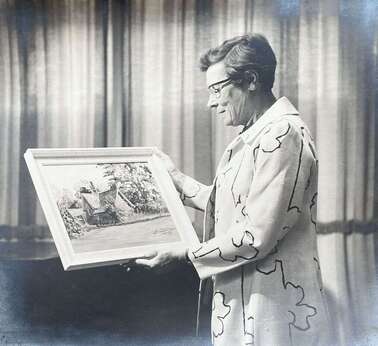 Mary accepting a gift at her retirement celebration
Mary accepting a gift at her retirement celebration
All good things must come to an end eventually, and in 1971 Mary chose to hang up her teaching hat and retire from the Kent Rural Music School. She had spent eleven years with the school, building the Tonbridge center to roughly 1,500 students. She was also entering her 60s and wished to spend time composing, performing, and traveling. There are a number of articles written about her retirement, giving her the title "Miss Music" and shouting from the rooftops how much of an impact she had on the students of Kent. Aside from her work there, she had built a life-long friendship with her fellow director Murial Anthony, who she would continue to visit, travel, and perform with through the remainder of her life.
Retirement in the Cotswolds
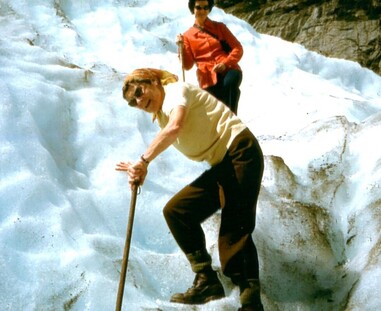 Mary exploring a New Zealand glacier
Mary exploring a New Zealand glacier
After Mary retired from the Kent Rural Music School she moved from her home in Kent and moved to the small Cotswolds village of Bisley in Gloucestershire. The word "retirement" rang a little bit differently for Mary. She was never without something she wanted to do, so while she was technically retired, she was also still very much hard at work. One of her main activities during this time was examining students across the U.K. and as far as New Zealand for the Associated Board of the Royal Schools of Music (ABRSM). She also still thoroughly enjoyed making music with others, and formed the Cotswold Baroque trio which consisted of soprano, violin, and spinet. Mary played spinet in this group, as she was dealing with a bit of arthritis, which hampered her piano playing. This group would play all throughout the Cotswolds, because the spinet was extremely portable. She also was fairly prolific as a composer during this period, composing roughly a third of her total output between 1971 and 1995.
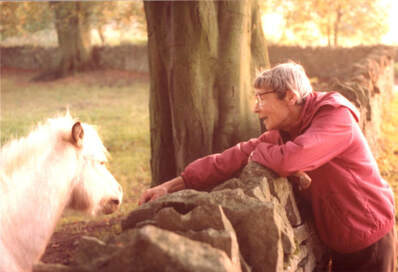 Mary sitting in the orchestra
Mary sitting in the orchestra
The last five years of her life, Mary was not in the best of health. She had a stroke in March of 1991, which affected her speech and the left side of her body. However, she was very determined to return to normal, and even bought a new car that allowed her to shift gears with her right hand. Eventually she did regain control of her left hand, allowing her to play her favorite Chopin pieces and even regained her voice, which returned to its usual strong, deep character. There had been a plan to celebrate her 80th birthday, but this was put on hold due to the stroke. The BBC did however, broadcast some of her music on BBC Radio Three in celebration.
In March 1995 she suffered her second stroke, and never really recovered. She was unable to mange on her own and lived out the remainder of her life at Winslow House, a nursing home in the nearby town of Stroud. She would pass away on November 19, 1996 and on September 20, 1997 her family and friends would gather for a memorial concert to honor her in Cheltenham. Her nephew would speak about her, stating that her biggest disappointment was the lack of recognition she received as a composer during her lifetime. Following her nephew's remarks was a concert of her works, performed by many of her friends.
In March 1995 she suffered her second stroke, and never really recovered. She was unable to mange on her own and lived out the remainder of her life at Winslow House, a nursing home in the nearby town of Stroud. She would pass away on November 19, 1996 and on September 20, 1997 her family and friends would gather for a memorial concert to honor her in Cheltenham. Her nephew would speak about her, stating that her biggest disappointment was the lack of recognition she received as a composer during her lifetime. Following her nephew's remarks was a concert of her works, performed by many of her friends.